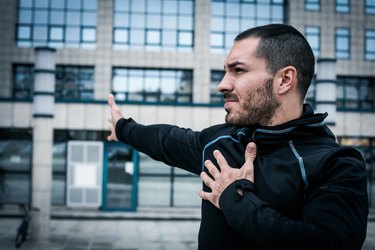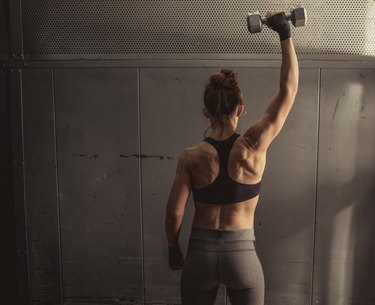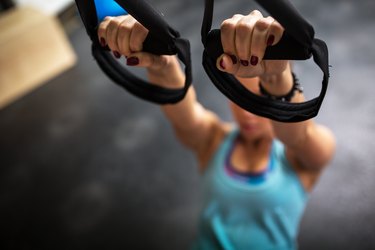
Feeling sore after a workout is known as delayed onset muscle soreness, or DOMS. Sore muscles after exercise are a result of muscle breakdown during a workout, particularly on the eccentric portion or downward phase of movements.
While DOMS isn't necessarily a sign of an effective workout, it does generally indicate that you've trained hard and if you feel DOMS in one arm and not the other, you may need to take a look at your muscle balance and the way you train.
Video of the Day
Video of the Day
So, if you're wondering "Why does my left arm hurt after exercise?" or "How do you get rid of left arm muscle pain?" for instance, we've got the answers — and solutions — below.
Why You're More Sore in One Arm After a Workout
1. You Have a Muscle Imbalance
If you're experiencing arm soreness in one limb but not the other, it could be due to a muscle imbalance. It's likely that your weaker side is the one that's getting sore, as it's having to work harder to complete the same amount of work as the strong side, leading to more muscle breakdown.
This imbalance could be caused by your overuse of one side, your joint structure or your day-to-day posture, per the American Council on Exercise (ACE).
2. You Have a Muscle Strain or Other Injury
If you're feeling pain — not just soreness — in one arm, you may have injured it. Muscle strains, sprains and tendonitis are all common workout injuries that could be the culprit of pain in one arm.
Muscle Strain
A strain happens when one of your muscles is stretched so far that it tears, according to the Cleveland Clinic. The symptoms of a strain are:
- Pain
- Weakness
- Muscle spasms
- Bruising
- Swelling
Treatment includes resting, icing and elevating your strained muscle. When it comes to applying ice to your injured muscle, use an ice pack every 10 to 15 minutes every hour for the first 24 hours after your injury, per the Cleveland Clinic. After day one, ice it every 3 to 4 hours. You can also use over-the-counter NSAIDs (like aspirin or ibuprofen) as a pain reliever for sore muscles.
Prevent muscle strains by properly warming up your muscles before exercise and not doing too many repetitive motions with them (take proper rest days to avoid overusing your muscles), per the Cleveland Clinic.
Muscle Sprain
A muscle sprain, per the Mayo Clinic, is when your ligaments — tissue that connects two bones together in your joints — tear or stretch. The symptoms of a strain are:
- Hearing or feeling a pop
- Pain
- Swelling
- Bruising
The treatment for a sprain is the same as a strain (see above). See your doctor if you can't move your joint, have pain over the bones of your joint or your joint feels numb.
Prevent muscle sprains by stretching and strengthening your muscles on a regular basis.
Tendonitis
Tendonitis is when your tendon — the connective tissues between your muscles and bones — become inflamed, according to the Mayo Clinic. The symptoms of tendonitis are:
- Pain
- Tenderness
- Mild swelling
The treatment for a sprain is the same as a strain (see above). Tendonitis may take a few months to fully heal, and physical therapy may beneficial during this time.
Prevent tendonitis by warming up your muscles before each workout, avoiding repetitive movements, suddenly increasing the amount or intensity of your training or placing too much stress on your tendons.
Warning
According to the National Health Service U.K. (NHS), one of the symptoms of a heart attack is pain that spreads from your chest to your arms. Usually, this affects the left arm, but it can happen in both arms.
Other symptoms include:
- Chest pain
- Shortness of breath
- Nausea or vomiting
- Lightheadedness or dizziness
- Sweating
- Coughing or wheezing
- Overwhelming anxiety (similar to a panic attack)
If you're experiencing any of these symptoms, seek medical care immediately.
How to Prevent Single-Arm Muscle Soreness
1. Delve Into Dumbbells
Ditching your barbell and machines in favor of dumbbells is an effective way to fix any muscle imbalances and ensure both sides are worked evenly, according to Elevate Fitness. This is because your weaker arm has to carry the load on its own, rather than relying on your stronger arm to help.
If you're used to performing an upper-body workout consisting of bench presses, machine shoulder presses, barbell rows, chin-ups and barbell curls for instance, try switching to dumbbell chest presses, dumbbell shoulder presses, dumbbell rows, single-arm pull-downs and dumbbell curls.
2. Go Hard on Your Weak Side
The best way to correct a muscle imbalance is to build up those weaker muscles, per Elite Fitness. After you've finished your normal arm workout, do a few extra sets of the exercises performed earlier on your weaker side. Over time, doing this will slowly even these muscle imbalances out.
3. Fix Your Form
You might find that you use poor form when training your weaker side, which actually leads to the stronger side feeling sore after the workout. On a biceps curl for example, you may perform the reps on your strong side with perfect form, which activates the biceps and leads to muscle breakdown and soreness.
On the weaker side, however, your biceps may not be strong enough to perform the movement on their own, leading to you using more body momentum. To make sure this doesn't happen, keep an eye on your form in a mirror, or have a training partner, personal trainer or exercise instructor let you know if your technique looks off.
It's also worth noting poor form or technique can cause one of the injuries we mentioned above.


